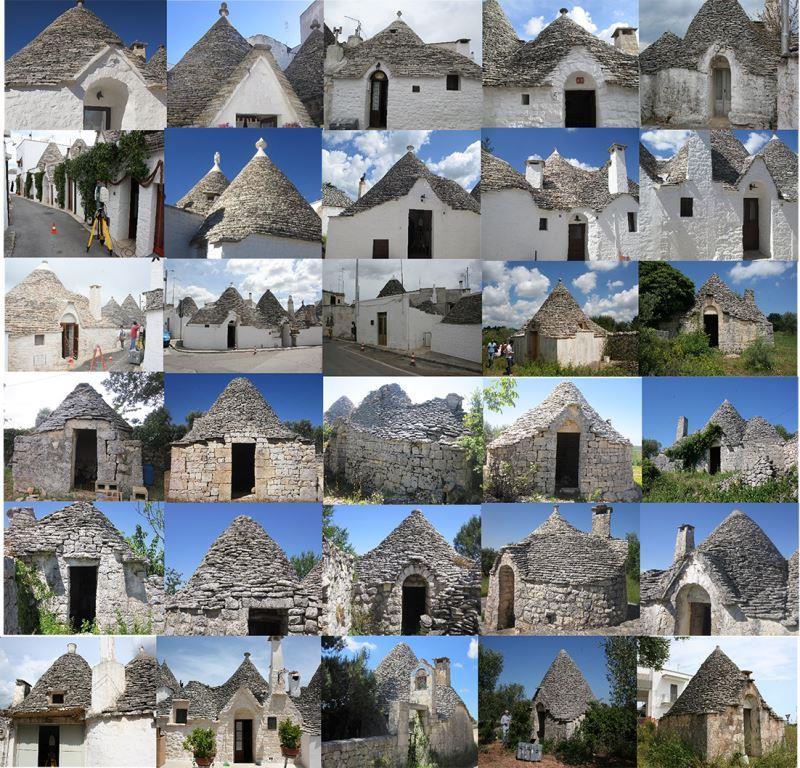The trulli , limestone dwellings found in the southern region of Puglia, are remarkable examples of drywall (mortarless) construction, a prehistoric building technique still in use in this region. The trulli are made of roughly worked limestone boulders collected from neighboring fields. Characteristically, they feature pyramidal, domed or conical roofs built up of corbelled limestone slabs.
The idea is to implement a monitoring database of several trulli after a program of quick screenings on site and a classification of these structure, by procedures specifically designed, in function of their vulnerability. This classification will be available for the Public Institutions and private subjects for monitoring these fascinating heritage structures and take actions for the conservation of the Trulli that result in worst conditions.

2018
|
Todisco, Leonardo Apuliabase: un sistema integrado de gestión del patrimonio aplicado a los Trulli Artículo de revista Patrimonio histórico de Castilla y León, (63), pp. 42–44, 2018. BibTeX @article{todisco2018apuliabase,
title = {Apuliabase: un sistema integrado de gestión del patrimonio aplicado a los Trulli},
author = {Leonardo Todisco},
year = {2018},
date = {2018-01-01},
journal = {Patrimonio histórico de Castilla y León},
number = {63},
pages = {42--44},
publisher = {Fundación del Patrimonio Histórico de Castilla y León},
keywords = {},
pubstate = {published},
tppubtype = {article}
}
|
2017
|
Todisco, Leonardo; Sanitate, Giuseppe; Lacorte, Giuseppe Geometry and Proportions of the Traditional Trulli of Alberobello Artículo de revista Nexus Network Journal, 2017, ISSN: 1590-5896. Enlaces | BibTeX @article{Todisco2017b,
title = {Geometry and Proportions of the Traditional Trulli of Alberobello},
author = {Leonardo Todisco and Giuseppe Sanitate and Giuseppe Lacorte},
url = {http://link.springer.com/10.1007/s00004-016-0326-4},
doi = {10.1007/s00004-016-0326-4},
issn = {1590-5896},
year = {2017},
date = {2017-01-01},
journal = {Nexus Network Journal},
publisher = {Springer International Publishing},
keywords = {},
pubstate = {published},
tppubtype = {article}
}
|
2016
|
Todisco, Leonardo; Sanitate, Giuseppe Static stability of trulli Artículo de revista Materials and Structures, 49 (7), pp. 2893–2905, 2016, ISSN: 1359-5997. Resumen | Enlaces | BibTeX @article{Todisco2016f,
title = {Static stability of trulli},
author = {Leonardo Todisco and Giuseppe Sanitate},
url = {http://link.springer.com/10.1617/s11527-015-0693-4},
doi = {10.1617/s11527-015-0693-4},
issn = {1359-5997},
year = {2016},
date = {2016-01-01},
journal = {Materials and Structures},
volume = {49},
number = {7},
pages = {2893--2905},
abstract = {Trulli are remarkable examples of corbelled masonry structures commonly located in Apulia, Italy. This paper focuses on their statics. Trulli domes transfer loads in paths that follows meridians and parallels: idealization of the dome as a system of independent arches is not admissible. The aim of this research is to present a simplified methodology for assessing their stability against vertical static loads and for classifying trulli in a database in order to identify those which are in the worst conditions. The goal is achieved by adopting a static index of stability (St. I.) that takes geometry into account. The methodology has been developed within the framework of the Apuliabase Project and it has been applied to the structural vulnerability evaluation of 30 case studies. The same philosophy can be extended to other structural typologies exhibiting similar structural behaviour.},
keywords = {},
pubstate = {published},
tppubtype = {article}
}
Trulli are remarkable examples of corbelled masonry structures commonly located in Apulia, Italy. This paper focuses on their statics. Trulli domes transfer loads in paths that follows meridians and parallels: idealization of the dome as a system of independent arches is not admissible. The aim of this research is to present a simplified methodology for assessing their stability against vertical static loads and for classifying trulli in a database in order to identify those which are in the worst conditions. The goal is achieved by adopting a static index of stability (St. I.) that takes geometry into account. The methodology has been developed within the framework of the Apuliabase Project and it has been applied to the structural vulnerability evaluation of 30 case studies. The same philosophy can be extended to other structural typologies exhibiting similar structural behaviour. |


